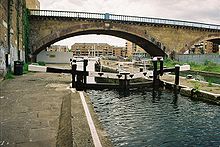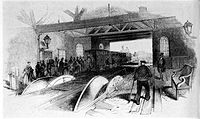- London and Blackwall Railway
-
London & Blackwall Railway Legend



Fenchurch Street 



Minories (1840-1853) 



Aldgate goods 



East Smithfield (London Docks) goods 



Leman Street (1877-1941) 



Commercial Road goods 



Cannon Street Road (1842-1848) 





East London Railway 



Shadwell and St George's East (1840-1941) 



Stepney (now Limehouse) 



Stepney Junction 



Regent's Canal 



Burdett Road (1871-1941) 



Gas works 







To London, Tilbury & Southend Railway 





Metropolitan District Railway 



Bow Road (1892-1949) 





North London Railway 



Victoria Park & Bow (1849-1850) 





Eastern Counties Railway to Liverpool Street 



Eastern Counties Railway to Essex 



Limehouse (1840-1926) 



West India Docks (1840-1926) 



Harrow Lane sidings 



Millwall Junction (1870-1926) 















GWR goods depot 





GNR goods depot (closed 1968) 





South Dock (1871-1926) 





PLA goods yard (for West India Docks) 



Millwall Docks (1871-1926) 





Millwall Docks goods (1872-1925) 



North Greenwich (1872-1926) 





Poplar Dock goods (1882-1951) 



Poplar (1840-1926) 



East India Docks goods (1859-1961) 





Blackwall (1840-1926) Originally called the Commercial Railway, the London and Blackwall Railway was a railway line in east London, England. It ran from the Minories to Blackwall via Stepney, with a branch line to the Isle of Dogs, thus connecting central London to many of London's docks in the 19th and 20th centuries. It was operational from 1840 until 1926 (for passengers) and 1968 (for goods services) - ultimately closing after the decline of inner London's docks. Much of its former infrastructure was later reused as part of the Docklands Light Railway. The London and Blackwall was leased by the Great Eastern Railway in 1866, but remained independent until absorbed into the newly formed London and North Eastern Railway at the 1923 Grouping.[1]
Contents
History
 Original bridge at Limehouse on the London and Blackwall Railway. It now carries a branch of the DLR. The iron fencing was a feature of the line and was popular with passengers as it gave a quieter ride than the brick walling of the nearby London and Greenwich Railway[2]
Original bridge at Limehouse on the London and Blackwall Railway. It now carries a branch of the DLR. The iron fencing was a feature of the line and was popular with passengers as it gave a quieter ride than the brick walling of the nearby London and Greenwich Railway[2]
It was authorised by an Act of Parliament entitled "An Act for making a Railway from the Minories to Blackwall, with Branches, to be called "The Commercial Railway" dated 28 July 1836 in the reign of William IV.
The engineer of the line was intended to be John Rennie, but the project’s City financiers favoured Robert Stephenson, believing that they would also benefit from the knowledge and wisdom of his respected father George. Although, because of the Act, Robert Stephenson had to follow Rennie’s route, and use the obscure track gauge of 5 ft 0 1⁄2 in (1,537 mm), he was free to choose his own method of propulsion. Drawing on his experience with the Camden Incline on the London and Birmingham Railway he decided upon cable-haulage from stationary steam engines.
The line opened on 6 July 1840, and the company changed its name to the London and Blackwall Railway on completion of an extension to Fenchurch Street railway station, just within the City boundary, in 1841. A line from Stepney (now called Limehouse) linking it with the Eastern Counties Railway at Bow was opened in 1849, at which time the line was converted to steam locomotive operation, and the track converted to 4 ft 8 1⁄2 in (1,435 mm) Standard gauge. This was joined to the new London, Tilbury and Southend Railway in 1858, allowing that company’s trains to run more directly into Fenchurch Street.
In 1852 the North London Railway had linked up with the L&BR at Poplar, and Fenchurch Street also became the terminus for that line until Broad Street opened in 1865. In 1871 another branch line, the Millwall Extension Railway, opened from Millwall Junction to Millwall Docks to serve the West India Docks better. A year later the line was extended further to North Greenwich, subsequently the site of the original Island Gardens DLR station.
In 1893 the Fenchurch Street-Stepney line was widened to four tracks, but by the turn of the century traffic to Blackwall and the Isle of Dogs was dropping. Passenger services east of Stepney to North Greenwich and Blackwall were stopped on 3 May 1926, and the minor stations at Leman Street and Shadwell were closed in 1941. The junction at Stepney was disconnected in 1951, restricting access to the curve via Limehouse, but this itself was abandoned in 1963. Access for occasional goods services to Blackwall and North Greenwich via the North London Railway at Poplar continued until 1968, but with the closure of the docks the line was completely abandoned, leaving only the Fenchurch Street–Stepney section still in use, by the LT&SR.
When the Docklands Light Railway opened in 1987, it reused much of the L&BR line between Minories and Westferry Road. Additionally, part of the viaduct at North Greenwich for the line to the original terminus between Mudchute DLR station and Island Gardens survived and was used, though this section was demolished when the extension to Lewisham was constructed and those stations replaced with ones nearby but below ground.
Cable haulage
 Minories station on the LBR, circa 1840. The winding drums and Cooke-Wheatstone “needle” telegraph instrument (left foreground) are shown. Note the lever-operated brake to keep the cable taut during unwinding.[2]
Minories station on the LBR, circa 1840. The winding drums and Cooke-Wheatstone “needle” telegraph instrument (left foreground) are shown. Note the lever-operated brake to keep the cable taut during unwinding.[2]
As originally built the line was 3½ miles long, with double track. These were bi-directional and were operated independently of each other. Indeed, on the opening of the line only one track was complete and the other was not brought into use until one month later. Each track was provided with a double length of hemp rope: as an engine was winding in from one end an equivalent length of rope was being paid out at the other. Fourteen miles of rope (with metal swivels inserted at intervals to resist entanglements) were therefore required in all. On journeys from the terminus cars were dispatched in two groups: the first group of four cars for the three most distant stations (the terminus stations, as the most important, received two cars per trip) and the second group destined for the three nearest. Each rearmost car was released (“slipped”) as the convoy passed through its destination station. When the extension to Fenchurch Street was brought into use the pair of cars for that station was slipped from the rope at Minories as before, but the brakes were not applied. Momentum carried them up the slight slope to the new platforms. “Slipping” and “pinning” (attaching) was controlled from an open platform at whichever end of a car was leading, using levers connected to iron grips beneath the carriage floor.[3]
It was obviously dangerous to use the reverse method to pick up cars on journeys to the terminus, so all the cars were “pinned” to the cable at their respective stations and started simultaneously with the convoy departing from the terminus (the timing co-ordinated by an early example of the Cooke-Wheatstone electric telegraph). They arrived in the end station at intervals and a new train gradually assembled itself, with the pair of cars from the far terminus becoming the lead pair for the return trip. The timetable was very simple: a train every fifteen minutes.
Power was provided by eight marine steam engines from Maudslay, Sons and Field, providing for four in use and four in maintenance. The Minories winding house had four at 110 h.p. but the engines at Blackwall were only at 75 h.p. as the overall gradient of the line fell from the west, where it was built on brick arches, to the east.
The line was converted to use steam locomotives in 1848, partly because wear on the rope proved greater than anticipated (a steel-wire replacement had been tried but this twisted and kinked ferociously) and partly in consequence of the intended 1849 extensions. A light roof over the tracks was provided where they passed near to timber stores or shipping, because of the anticipated fire risk from locomotive sparks. It then became possible to travel directly between intermediate stations, without a detour by way of a terminus.
Stations
The stations on the line were:
Station Opened Closed Notes Fenchurch Street 1854 † Minories (resited) 1841 1853 Minories (original) 1840 1841 Site used for Tower Gateway in 1987 Leman Street 1877 1941 Cannon Street Road 1842 1848 Shadwell 1840 1941 Stepney 1840 † 1923 renamed Stepney East, 1987 renamed Limehouse Limehouse 1840 1926 not to be confused with the above West India Docks 1840 1926 Millwall Junction 1871 1926 Poplar 1840 1926 not to be confused with Poplar DLR station Blackwall 1840 1926 not to be confused with Blackwall DLR station † = still open, served by c2c
Branch to Bow from Stepney, called the London and Blackwall Extension Railway (opened 1849, joint-operated with the Eastern Counties Railway):
- Burdett Road (opened 1871, closed 1941)
- Bow Road (opened 1892, closed 1949)
- Victoria Park & Bow (opened 1849, closed 1850, interchange with Eastern Counties Railway - not to be confused with Victoria Park or Bow stations)
Branch to North Greenwich from Millwall Junction, called the Millwall Extension Railway:
- South Dock (opened 1871, closed 1926)
- Millwall Docks (opened 1871, closed 1926)
- North Greenwich (opened 1871, closed 1926; not to be confused with North Greenwich tube station)
References
- Notes
- ^ Awdry, Christopher (1990). Encyclopaedia of British Railway Companies. London: Guild Publishing. p. 144. CN 8983.
- ^ a b Timbs, John (1840-07-11). "The London and Blackwall Railway". The Literary World (London: G. Berger) 3 (68): 225. http://books.google.com/?id=mG0EAAAAQAAJ&pg=PA225&dq=%22London+and+Blackwall+Railway%22. Retrieved 2008-09-29.
- ^ Robertson (1848: 83)
- Bibliography
- Gordon, W.J. (1910): Our Home Railways (volume two). Frederick Warne & Co, London, England.
- Jackson, Alan A. (1978): London’s Local Railways. David & Charles, Jackson, Vermont, U.S.A. ISBN 0-7153-7479-6
- Robertson, Andrew John (1848). "Blackwall railway machinery". The Civil Engineer and Architect's Journal (New York: John Wiley & Sons) XI (March 1848): p83. http://books.google.com/?id=swoAAAAAMAAJ&pg=RA2-PA83&dq=minories. Retrieved 2007-11-30.
London and Blackwall Railway Stations London and BlackwallBlackwall · Cannon Street Road · Fenchurch Street · Leman Street · Stepney · Limehouse · Minories · Poplar · Shadwell and St George's East · West India Docks
London and Blackwall ExtensionMillwall Extension
Minories stationRelationships Absorbed by the Great Eastern Railway in 1866 ►Categories:- Early British railway companies
- Transport in Tower Hamlets
- London and Blackwall Railway
- Railway companies established in 1836
- Railway lines opened in 1841
- Closed railway lines in London
- History of rail transport in London
- 1836 establishments in England
Wikimedia Foundation. 2010.
